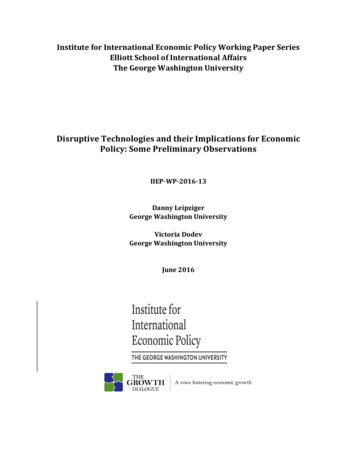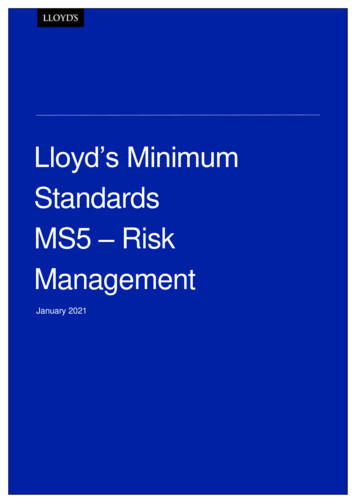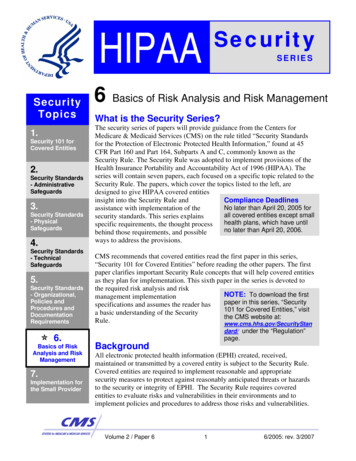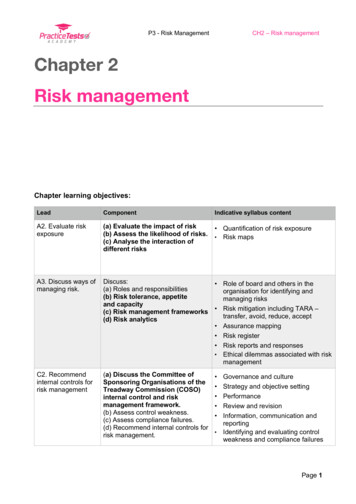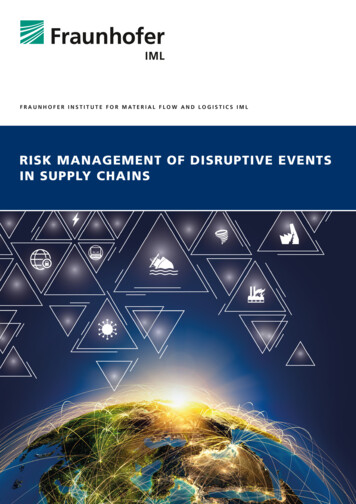
Transcription
F R A U N H O F E R I N S T I T U T E F O R M AT E R I A L F L O W A N D L O G I S T I C S I M LRISK MANAGEMENT OF DISRUPTIVE EVENTSIN SUPPLY CHAINS
WHITEPAPERRISK MANAGEMENT OF DISRUPTIVE EVENTS IN SUPPLY CHAINSMANAGEMENT SUMMARYDisruptive events and their effects are not a new phenomenon that needs to be considered in the context of riskmanagement. There have always been unforeseeableevents with significant impacts and little to no warningtime in business practice. However, the developmentof worldwide value-added structures to move towardglobal and networked supply chains with closely integrated logistics and value-added processes, has greatlyincreased the vulnerability of individual supply chains.Longer transport distances, globally distributed supplierand customer structures and reliance on the functioning of tightly synchronised networks are susceptibleto massive impact in the event of an unplanned andperhaps even unforeseeable disruption. Increasing political and social uncertainties and the growing numberof extreme environmental and weather events due toclimate change continue to highlight the importance ofdisruption risk management [1].The best possible preparation and response to disruptions, together with the identification of potential dangers and the fastest possible recovery of supply chainsaffected by disruptions, is therefore an increasinglyimportant area within risk management. The increasingrelevance of this particular risk component must alsobe reflected in company structures, processes and ITsystems and in cross-company supply chains. Currently,only about 25% of the companies interviewed in asurvey identify, measure and report disruptive events ona company-wide basis and in integrated systems [2].2In many cases, current technologies to support the management of disruptive events, such as artificial intelligence, block chain or simulation, are already availableand integrated in software solutions. However, manycompanies have still not begun adapting processes andstructures or ensuring that employees have the organisational and technological skills to be able to realisethe potential that technology can make possible. Onthe other hand certain individual companies are alreadypreparing the entire supply chain for disruptive shocksin the best possible way through modern IT, customisedinternal organisation and collaboration with value creation partners.In preparing this white paper, technical experts anddecision-makers from industry and trade together withexternal knowledge carriers were involved in order toobtain the most comprehensive and cross-sector viewpossible on the topic of disruptive risks. Based on theseinterviews, four areas of activity were identified - riskawareness, transparency, flexibility and cooperation- for companies and supply chains, in which currentshortfalls in the instruments, methods and measuresused were the focus. The need to support employees,processes and functionalities have been identified inboth the preparatory proactive and reactive measuresand solutions. With regard to these areas of activity,technology-based approaches and solutions are presented, which are intended to provide support whilegetting to grips with the existing challenges.
WHITEPAPERRISK MANAGEMENT OFDISRUPTIVE EVENTS INSUPPLY CHAINSCONTENTSManagement Summary.2Motivation and Introduction.4Shortfalls and Required Action for the Management of Disruptive Events .6Shortfalls of Current Instruments in Risk Management.6Action Required for Risk Management.9New Technologies and Methods .12Current Trends and Developments in Supply Chain Management.12Technologies for Dealing with future Disruptive Events.12Methods and Solutions for Dealing with Disruptive Events.14Assessing the Availability of Solutions and Technologies and the Current Action Required.17Conclusion and Outlook .18References.19AUTHORSLorenz Kiebler, Fraunhofer IMLDietmar Ebel, Fraunhofer IMLPhilipp Klink, Fraunhofer IMLSaskia Sardesai, Fraunhofer IMLCONTACTFraunhofer Institute for Material Flow andLogistics IMLJoseph-von-Fraunhofer-Str. 2– 444227 DortmundINSTITUTE MANAGEMENTProf. Dr.-Ing. Uwe ClausenProf. Dr. Michael HenkeProf. Dr. Michael ten Hompel (Managing Director)IMAGE LICENCE - COVER PICTUREAND INNER SECTION Anton Balazh, lassedesignen, Edelweiss, MaksimPasko - FotoliaCOVER, LAYOUT UND TYPESETTINGSabrina Peters, Fraunhofer IMLDOI10.24406/iml-n-599828 Fraunhofer IML, Dortmund 2020This white paper was issued with sponsorship fromOracle Germany.3
MOTIVATION AND INTRODUCTIONCurrent developments such as globalisation, the individualisation of customer requirements and products aswell as generally increasing environmental dynamics arecausing supply chains to become increasingly complex.Supply chains span various countries, use closely synchronised transport and delivery windows and reduceinventories, costs and lead times by strengthening collaboration between the partners involved. However, ifthis fine-tuned collaboration is disrupted by unforeseenevents, the impact is even more significant if there isinadequate preparation. In addition, the susceptibilityof supply chains to disruptions fundamentallyincreases as networks and environmental volatilityprogress [3].As a result of the various trends, the environment ofglobal supply chains is developing towards a less deterministic and increasingly unpredictable setting, whichtherefore cannot be planned for [4], and can be summarised by the abbreviation VUCA: The combination ofvolatility, uncertainty, complexity and ambiguity meansconventional risk management instruments need to befurther expanded. Especially in environments that arecharacterized by VUCA attributes, there are many risksfor supply chains. Risks generally describe events thatcannot be predicted with certainty and deviations fromplanned results, which can be specified by the cause ofthe risk, a probability of occurrence and the effects ofdamage [5, 6]. In principle, positive opportunities thatcannot be predicted with certainty can also be considered as risks. In the general understanding of the term‚risk‘ and in terms of management, however, the termprimarily refers to negative loss events [3,7], hencethis meaning of the word is also used in this white paper.With regard to supply chains, risks negatively influencethe flow of information, materials, end products andalso financial flows between raw material suppliers andend customers in a value chain [3].4In general, supply chain risks - as a subgroup of all existing risks of a company - can be divided into internalsupply chain risks for material, financial or information flows such as production, liquidity or IT risks, andexternal supply chain risks such as political, social ormarket-related events and risks from natural disastersor general environmental events [8, 9]. Risks are highlyrelevant in the context of supply chain management,since any unplanned failure in one stage of the valuechain can affect the entire supply chain and, in theworst case, bring it to a standstill [10]. For 2019, asurvey [2] identified IT failures, storms, cyber risks, andpotential future terrorist acts or fire hazards as the mainreasons for supply chain disruptions with major consequences. What all these events have in common is thatthey result from non-deterministic, disruptive events,which mostly could not be predicted or could only bepredicted in the short term.Disruptive events and the risks resulting from thesecan be distinguished from operating risks on the basisof their probability of occurrence and their impact [11].In most cases, disruptive events are external in natureand have very low probabilities of occurrence that aredifficult to estimate. If they do occur, the consequencesare more serious than those of operational risks - suchas fluctuations in demand or fluctuations in productiontimes - as shown in Figure 1. [3, 12]The increasing awareness of the vulnerability ofglobal value networks to disruptive events has ledto the introduction of a structured risk assessment forsupply chains at a corporate and management level.This Supply Chain Risk Management (SCRM) focuseson the identification, evaluation and control of threatsand events that threaten companies involved in supplychains, transport routes, information flows or financialaspects of cooperative collaboration.
The importance of managing disruptive risks for acompany depends primarily on the scope and globalityof supplier and customer relationships. Even small, locally sourcing companies can be affected by disruptiveevents, but the vulnerabilities of deeply and broadlyintegrated supply chains as well as global supply chainsare increasing dramatically.In order to create a supply chain in which deviationsfrom plans and disruptions are identified as early as possible, cushioned by countermeasures and compensatedby flexible adjustments, both classic methods of riskmanagement and new IT solutions made possible byprogressive digitisation can be used. A resilient supplychain of this nature, which can return as quickly aspossible to the original or a desired and possibly evenmore ideal state after a disruption [3, 11, 13], implies ahigh degree of agility in reacting to unforeseen eventsor deviations from the plan [13].Characteristicsof theVariablesTo ascertain the current status and future potential forrisk management of disruptive events in supply chains,in the context of this white paper interviews wereconducted with various experts and managers fromdifferent industries as well as with external scientists,professors and consultants. The findings, assessmentsand contents of these interviews have been taken intoaccount when developing the fields of action and in theselection of the solution technologies presented. Theremaining necessary actions and an assessment of theavailability of current and future technologies are at theend of the white paper.Figure 1: DistinguishingDisruptive Event IIbetween disruptive andoperational risks [11]OperativeUncertaintiesDisruptive Event IDisruptive Event IIITime5
SHORTFALLS AND REQUIRED ACTION FOR THEMANAGEMENT OF DISRUPTIVE EVENTSThe capability for managing disruptions within a supplychain can be divided into four different phases before,during and after a disruptive event (see figure 2). Inthe first phase of readiness, the relatively undisturbedsupply chain can be proactively prepared for futuredisruptions. With these disruptions in particular, thereis often a variable, short advance warning time at leastfor parts of the supply chain, which could be used forshort-term preparations [11]. Disruptive events coverboth expected risks (the expected unexpected) such asearthquakes in vulnerable regions or hurricanes duringthe Atlantic hurricane season, as well as unexpectedrisks (the unexpected unexpected) like global pandemics, terrorist attacks, or fires. While proactive preparation for fundamentally expected disruptive disturbancesis possible, the preparation for unexpected disruptionsis not instantly possible.CapacityAt the moment a disruption actually happens, the reaction phase begins, in which control is (re-)gained andfurther damage should be prevented if possible. Afterthe initial disruption and its consequences have beenovercome, the recovery phase begins, which is intended to make up for and compensate for the accumulated backlogs or consequences in the best possible way.Initial LevelDisruptive EventDirectConsequencesResponseSHORTFALLS OF CURRENT INSTRUMENTSIN RISK MANAGEMENTThe instruments currently used for risk managementcan be divided into proactive instruments for preparinga supply chain for disruptions in the readiness phaseand reactive instruments specifically for gaining controlin the reaction and recovery phase. Depending onthe sector and the size of the company, it is apparentthat the instruments used can vary considerably. Theproactive measures in the readiness phase shouldensure a general increase in the resilience of a supplychain, the earliest possible identification of risks andthe preparation of a rapid and targeted risk responsein the event of damage.Return to the initialLevel or Increase inCapacityFigure 2: Phases of a resilientsupply chain [3, 11, 15]MeasureseffectiveFull Extentof DamageReadinessIdeally, the original or even a higher final level acrossthe entire supply chain can ultimately be achieved inthe growth phase. [3, 14] In the following sections,currently used risk management instruments for disruptive events in supply chains are examined for potentialshortfalls in order to subsequently identify the corresponding needs for action.RecoveryGrowthTime6
At present, these risk reactions and the technical supportthereof are primarily organised at a company level,as the collaboration between the value-added partnersin this area is often insufficiently prepared and thetechnological support for this is inadequate.The systematic identification of potential disruptions inthe supply chains takes place at different intensities anddegrees of standardisation. Many of the surveyed companies in various sectors turn to external informationservices for information and trend analysis to be able toidentify future changes in demand or existing risks asearly as possible. Both environmental risks and the effects of risks on demand or supply chains are taken intoconsideration. In principle, detection and identificationis known to be generally associated with many risks butmany companies do not make optimal use of the earlywarning time due to a lack of awareness of risks, alack of transparency and a lack of instruments Insome cases they are unable to identify specific riskspromptly.»Fukushima, earthquakes, volcanic eruptions, coronavirus: these affect you. And then it‘s just a question ofhow fast and how hard you get hit, and that dependson proactive risk management. In any case, you have todeal with it and you need reactive organisation.«Dr. Stefan Geraedts, Director Logistics,Behr-Hella Thermocontrol GmbHThe proactive definition of action plans is intended toensure that the response phase follows the risk event asquickly as possible in terms of supply chain agility. Dueto a lack of preparation of the measures necessaryto achieve control or to reduce damage, these measuresare often uncoordinated, delayed and, in the worst case,can even be ineffective. This comprehensive preparationis much more distinct in larger companies due to various disruptive risks they have experienced in the pastand the required capacities which smaller and newercompanies do not have. Even the preparatory measuresrelating to the ability to act in the event of a crisis, forexample the regulation of authorities and responsibilities within corporate governance, are often notadapted to all possible risks and are not organised in astructured manner. It is only with such organisationalpreparation within corporate governance and the rapidformation of a task force that specific risk responses canbe decided and implemented quickly and precisely.The reactive instruments are used immediately afterthe disruption has occurred or after the early warning- which is only possible to a limited extent - in order tostabilise the supply chain and control the disruptions inthe direct response and recovery phases. After an identification as close to real time as possible, the effects onthe own supply chain would have to be analysed andthe most effective measures would have to be selectedand implemented.»What can be adapted in any case is a ‚real time‘ logging, namely a real-time information transfer for thesupply chain. We need more transparency regardingwhere our parts are in the material flow. We need tocreate an event management system that tells us therelevant events about these real-time events on thetransport route.«Supplier Manager, Automotive Manufacturer7
WHITEPAPERRISK MANAGEMENT OF DISRUPTIVE EVENTS IN SUPPLY CHAINSIn complex supply networks, the ability to react asquickly and effectively as possible in terms of cost andbenefit to disruption-related, dynamic bottlenecks isalready an essential part of operating business. As aresult, international corporations with wide-reaching,global supply chains and complex, closely synchronizedsupply chains are already using IT tools for complexitymanagement in their day-to-day planning, such as special plans or the use of previously planned alternativesand redundancies. Companies with less wide-reachingand less deeply integrated supply chains are often notprepared for dynamic responses in terms of softwareand methods, which can have negative time, financialand organisational effects.»In the automotive industry we are used to dealing withcomplexity and also with global networking. This mightdistinguish us from other industries or even from othercompanies.«Dr. Dirk Dreher, Head of Logistics Planning,BMW GroupFor smaller companies that are less closely integratedinto more vulnerable global supply chains, the importance of structured risk management of disruptiveevents often only becomes apparent when such a situation with major effects on the company first arises. Theinternal company core data is often not structured insuch a way that allows for the analyses and informationrequirements that are actually necessary. For example,although central contact details of suppliers or customers are often maintained for invoicing and contactpurposes, the geographical distribution of locations ororigins of goods behind these sales offices or companyheadquarters are not recorded in a structured way.8Therefore it is very difficult to quickly analyse the effectsof disruptions on the company‘s own supply chain.This cooperation with customers and suppliers, whichis necessary in many cases, shows weaknesses due tounregulated communication channels and systemsas well as challenges with regard to data sovereigntyand trust. In the event of an incident, information isoften transmitted late or only in batches, dependingon how the risks are assessed and available capacities.Often, out of fear of misuse of the data provided, onlythe immediately essential data is provided. Ingood partnerships between companies, however, thiscommunication goes far beyond these areas.Companies of all sizes also rely on external sources ofinformation, forecasts and assessments for risk identification in the readiness phase as well as in the specificresponse and recovery phase. The comprehensive monitoring of the various sources of information and thepresentation of the vulnerabilities of the supply chainis often not structured and not supported by thesystem in terms of processes.»We are well versed in our core business and expand thisinternal knowledge by purchasing external knowledgewhen necessary. As a trading company, you need toknow which product groups can offer reliable stability.What and how the customer will consume in the futureis therefore crucial. For this reason, we work togetherwith global trend analysis bureaus.«Buying Director, Retail Industry
ACTION REQUIRED FOR RISKMANAGEMENTAs part of the expert interviews conducted, variousfields of action can be identified which combine thecurrent requirements for improved support of riskmanagement processes.For proactive risk management, the need for furtherdevelopment of the supply chain organisation intoa more flexible, transparent and thus more resilientsupplier network and improved early detection wereidentified as important fields of action. The evolutionof the supply chain organisation towards a resilientsupply chain in proactive risk management also has asignificant impact on risk response and recovery froma disruptive incident. The fields of action of proactiverisk management therefore also represent importantaspects of reactive risk control. If the basic flexibility andtransparency of the supply chain has not been optimisedin a focused manner before the risk event, this cannotbe achieved in an ad hoc way in the disruptive crisissituation as reaction and recovery is no longer possible.Exactly this transparency internally and along the supplychain, as well as the flexible reaction possibilities and redundancies of the supply chain are the basis for reactiveinstruments and measures.Based on this insight, the fields of action currently identified in business practice of transparency, flexibility(including redundancy) and cooperation across thevarious sectors and company sizes can be summarizedfor both reactive and proactive risk management. Theseaspects also coincide with the factors identified in theliterature for supply chain resilience [3, 11]. In addition,risk awareness, i.e. the identification and assessmentof possible disruptive risks and the fundamental creation of a risk culture and organisation, is another centralaspect of supply chain risk management. These fouridentified fields of action are described below.1.Risk AwarenessThat disruptive events in global supply chains are inevitable was a point emphasised in all expert interviews. Inaddition to this fundamental recognition that disruptive risks cannot be avoided, the field of action ofrisk awareness primarily comprises the most completepossible identification of potential disruptive risks affecting the supply chain, the structured developmentof action plans and the best possible early recognition of risks in order to extend the short warning times.Figure 3: Fields of action for theTransparencyFlexibilityCooperationRisk Awarenessrisk management of disruptiveevents9
WHITEPAPERRISK MANAGEMENT OF DISRUPTIVE EVENTS IN SUPPLY CHAINS»You can create an awareness in advance where thesedisruptive risks are. And then, in my opinion, the moment you become aware of it, you need to set up astrategy: how do you deal with this risk? There may bea way to create a safety stock. Or the risk is so big thatyou definitely need a second source.«Dr. Stefan Geraedts, Director Logistics,Behr-Hella Thermocontrol GmbH»Preparing a contingency plan is no longer purely reactive crisis management, but is already part of a proactiveapproach. That is why I would always favour proactiverisk management. This doesn‘t mean that risks can becompletely avoided, but you can at least reduce theirimpact.«Prof. Dr. Michael Henke, Director of FraunhoferInstitute for Material Flow and Logistics IMLAssessing the impact of the various possible disruptionsas realistically as possible is also an important task inthis field of action, as these assessments can be used tomanage priorities and investments.2.TransparencyDuring the course of the interviews, transparency wasidentified as an important field of action, particularlywith regard to the company‘s own information andcore data, the transfer of information betweencompanies in a supply chain and the integration ofexternal environmental information and developments.»What happens if, for example, logistics locations canno longer be productive overnight due to unforeseenevents? We have developed appropriate scenarios andstrategies for dealing with these situations.«Logistics Department Manager, Retail IndustryAfter an incident has occurred, the rapid identification of the fault, its effects on the supplier and customer supply chain and the definition of the necessarymeasures is both important and complicated. Most ofthe companies surveyed only use an integrated, nearreal-time and technology-supported solution to a limitedextent or are currently planning a system introduction.10» Transparency is the factor that can make or breakwhether a risk is dealt with successfully or not. «Dr. Dirk Dreher, Head of Logistics Planning,BMW GroupAs was shown in the specialist interviews, however,this in-depth data transfer with suppliers is particularlycomplicated to implement in many cases due to different objectives, lack of trust, or different, competingcustomer relationships.
3.FlexibilityFlexibility describes the ability of a supply chain andthe companies involved to adapt to new circumstances [11]. Ideally, this flexibility will relate to suppliers, products, customers and internal processes, i.e.it affects the entire supply chain. A central area forachieving flexibility is the establishment of reliableredundancies. These redundancies can be implemented in relation to distributed or strategically retainedproduction capacities, different, geographically distributed suppliers of identical parts or safety stocks [15].During the course of the expert interviews, it becameclear that the possibilities of structured planning of resiliencies, especially in sourcing, are strongly influencedby the products purchased and regional conditions.Redundancy in material supply due to high safety stocksis usually not the solution of choice, both for reasons ofcapital commitment and due to the difficulty of forecasting future product shortages. In many companies,the analysis of these redundancy aspects takes placepurely manually, and not in a structured way. Even acentralised view and control of redundancies across thedifferent areas is only slowly being implemented in thecompanies.» If all partners in the value chain now suddenly had aflexibility corridor that was twice as large, then dealingwith disruptive events would, of course, be much betterthan if this were not the case. But the problem is thatflexibility is appreciated, but not necessarily paid for bythe customers. «Prof. Dr.-Ing. Axel Wagenitz, HamburgUniversity of Applied Sciences (HAW Hamburg)4.CooperationThe close and as far as possible trusting cooperation with the partners along the entire value chainrepresents a further success factor mentioned in theinterviews. The ideal picture includes not only cooperation with the direct supplier and the direct customer,but also cooperation with tier-n suppliers anddownstream customer entities. This cooperation alongthe entire supply chain, in particular, has to be focusedon as a factor that will become increasingly importantin the future. In relation to the matter of transparency,the questions of trust, autonomy and data sovereignty must be considered and addressed. On thesubject of cooperation, the issue of preventing the lossof value-added partners through financial shortages incrisis situations continues to be an increasingly important consideration.In summary, it can be seen, especially in IT support,that even internationally operating companies infailure-prone industries often react to disruptiveevents without specific software tools and structuresand switch to existing manual and non-standardtools. Communication with suppliers and customersalso often takes place without system support and, inthe event of a fault, without uniform standards. Bothinterviews and recent studies [2] have shown that if ITsupport is available at all, a great deal of it is only in theform of generally available spreadsheet tools. Reasonsfor this reluctance to invest in software-supported riskmanagement include budget restrictions, an outdated IT infrastructure, lack of personnel, fear ofcyber attacks and regulatory reasons. Establishingthis fundamental readiness for system- and technologysupported risk management of disruptions is an internalcompany task that must be dealt with initially in orderto realise further potential.11
NEW TECHNOLOGIES AND METHODSCurrent technological developments enable improved or new possibilities in risk management. Thesefundamental trends and technologies can enable thedevelopment of tools, specific measures and structuresthat further develop basic resilience and specific riskresponses.CURRENT TRENDS AND DEVELOPMENTSIN SUPPLY CHAIN MANAGEMENTAs shown in figure 4, supply chains are affected byvarious environmental developments as well asmarket and social trends. Based on these externaltrends and market developments, together with the increase in disruptive events, risk management must alsoadapt to the constantly changing circumstances inthe future [10, 16, 17].In response to these external demands on companiesand supply chains, various internal trends can be identified that respond to these changes. These endogenousdevelopments [10] focus on the following areas: Digitalisation of business processes Business analytics Transparency in the value-added chain Networking/cooperation Automation DecentralisationBoth the results of the expert interviews and previousstudies show that small and medium-sized enterprisesin particular are only just beginning to fully recognisethe potential of digitalisation, including for risk management, and to derive actions from this. The larger andmore international a company is structured, the moreaspects of data transparency and digital networkingand support are already implemented.TECHNOLOGIES FOR DEALING WITH FUTURE DISRUPTIVE EVENTSThe trends described above place increased demandson risk management, but at the same time open uppotential to meet the identified needs for action,especially through end
supply chain risks for material, financial or informa-tion flows such as production, liquidity or IT risks, and external supply chain risks such as political, social or market-related events and risks from natural disasters or general environmental events [8, 9]. Risks are highly relevant in the context of supply chain management,

